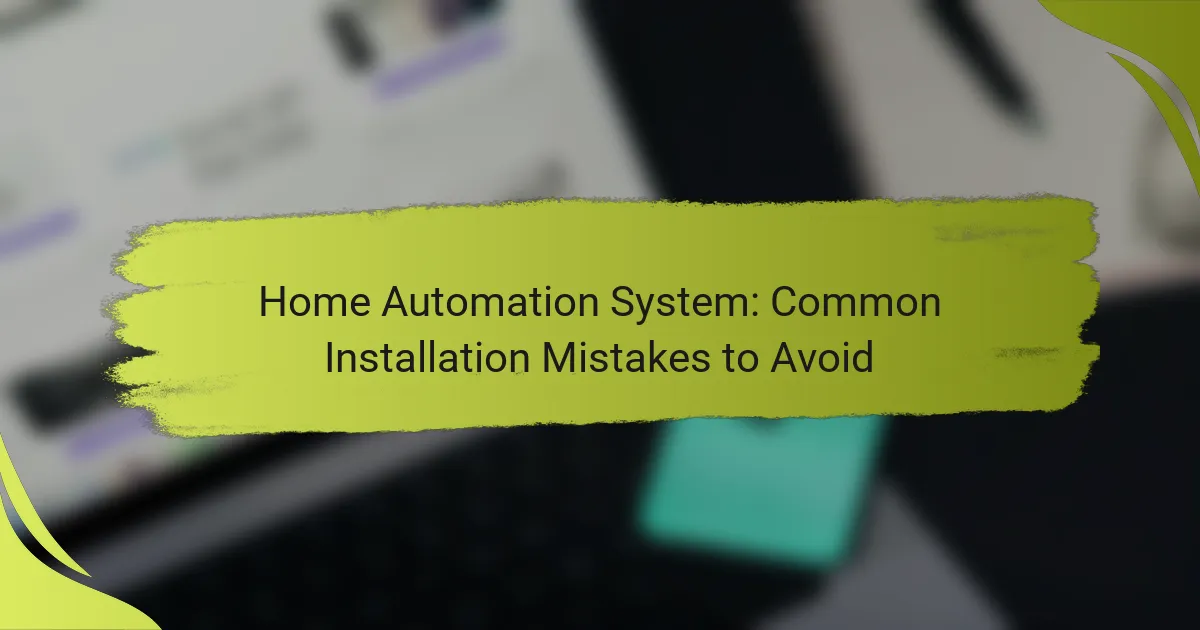Installing a home automation system can greatly enhance your living experience, but common mistakes can hinder its effectiveness. By focusing on careful planning, ensuring compatibility, and prioritizing user experience, you can avoid pitfalls that may compromise your setup. Understanding the technology and seeking professional help when needed are essential steps to create a reliable and efficient automation system.
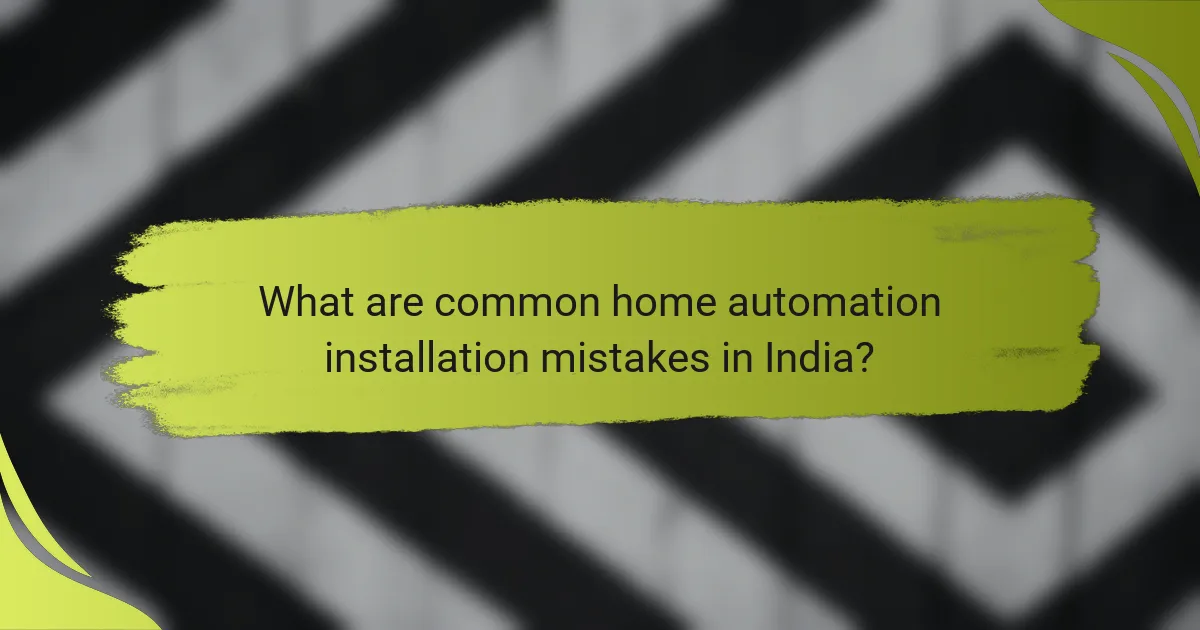
What are common home automation installation mistakes in India?
Common home automation installation mistakes in India include poor planning, overlooking compatibility, neglecting professional help, ignoring user experience, and skipping system updates. Addressing these issues can significantly enhance the functionality and reliability of your automation system.
Poor planning and layout
Poor planning and layout can lead to inefficient use of devices and resources. Before installation, assess the layout of your home, considering factors like device placement, connectivity, and power sources. Create a detailed plan that outlines where each device will be located to ensure optimal performance.
For example, placing smart speakers in corners may hinder sound quality, while positioning sensors away from direct sunlight can improve their effectiveness. A well-thought-out layout minimizes future adjustments and enhances user satisfaction.
Ignoring compatibility issues
Ignoring compatibility issues can result in devices that do not work well together, leading to frustration and wasted investment. Always check that the devices you choose are compatible with your existing systems and each other, especially when mixing brands or technologies.
For instance, if you have a smart home hub, ensure that all devices can connect to it seamlessly. Researching compatibility before purchase can save time and money, allowing for a smoother integration process.
Neglecting professional installation
Neglecting professional installation can lead to improper setup and functionality issues. While DIY installation may seem cost-effective, hiring a professional can ensure that your system is installed correctly and efficiently. Professionals have the expertise to troubleshoot potential problems that may arise during installation.
In India, many service providers offer tailored installation services for various home automation systems. Investing in professional help can enhance system reliability and longevity, ensuring that your investment pays off in the long run.
Overlooking user experience
Overlooking user experience can diminish the effectiveness of your home automation system. It’s essential to consider how users will interact with the system, including ease of use and accessibility. A complicated interface can lead to frustration and reduced usage.
For example, ensure that mobile apps or control panels are intuitive and user-friendly. Conducting user testing with family members can provide valuable feedback on how to improve the overall experience.
Skipping system updates
Skipping system updates can leave your home automation devices vulnerable to security risks and performance issues. Regular updates often include important security patches and feature enhancements that improve functionality. Make it a habit to check for updates regularly, ideally on a monthly basis.
In India, many devices offer automatic updates, but it’s wise to verify that this feature is enabled. Keeping your system updated not only enhances security but also ensures you are benefiting from the latest improvements and features available.

How to avoid installation mistakes for home automation systems?
To avoid installation mistakes for home automation systems, focus on careful planning and informed decision-making. Understanding your needs and the technology involved is crucial for a successful setup.
Conduct thorough research
Research is vital before installing a home automation system. Familiarize yourself with different types of systems, their features, and compatibility with existing devices. Look for user reviews and expert opinions to gauge performance and reliability.
Consider creating a list of your specific requirements, such as security, energy management, or entertainment. This will help narrow down your options and ensure you choose a system that meets your needs effectively.
Consult with experts
Consulting with experts can prevent costly mistakes during installation. Seek advice from professionals who specialize in home automation systems, as they can provide insights on the best products and installation practices.
Don’t hesitate to ask questions about potential challenges and solutions. An expert can help you understand the technical aspects and recommend the right equipment for your home, ensuring a smoother installation process.
Use reliable brands like Philips Hue
Choosing reliable brands, such as Philips Hue, can significantly reduce installation issues. Established brands typically offer better customer support, more robust products, and compatibility with various systems.
When selecting devices, prioritize those that have a proven track record for performance and user satisfaction. This can help ensure that your home automation system operates seamlessly and meets your expectations over time.
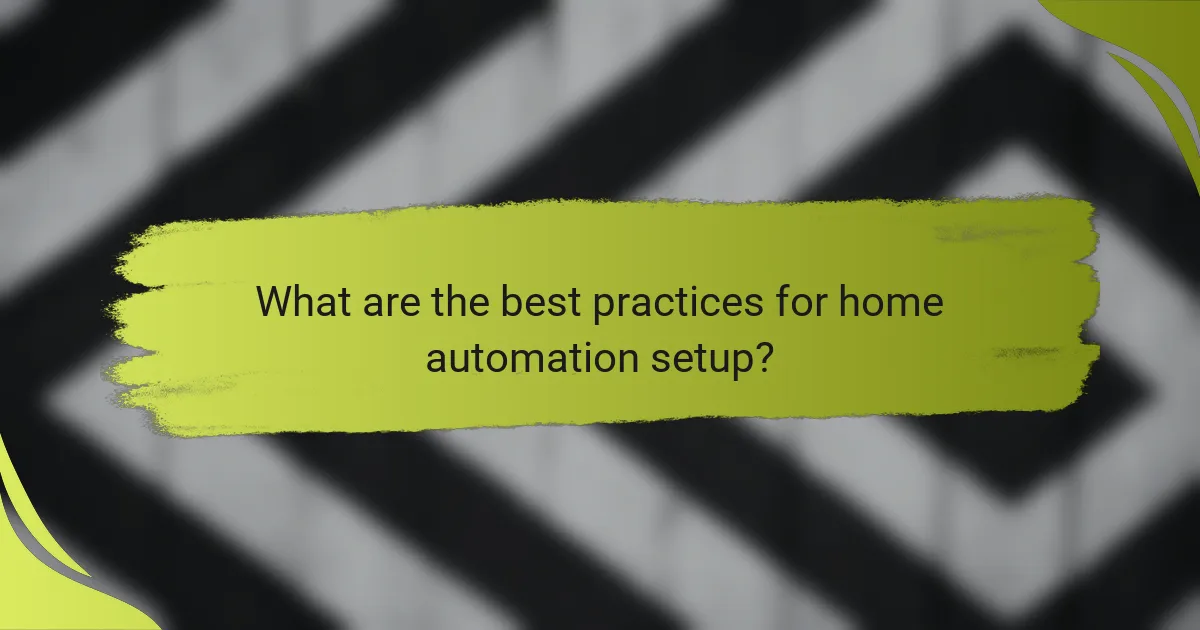
What are the best practices for home automation setup?
Best practices for home automation setup focus on ensuring ease of use, reliable connectivity, and thorough testing. By following these guidelines, you can create a seamless and efficient home automation experience.
Prioritize user-friendly interfaces
User-friendly interfaces are essential for a successful home automation system. Choose devices and applications that are intuitive and easy to navigate, reducing the learning curve for all users in the household.
Consider systems that allow for customization of the interface, enabling users to arrange controls according to their preferences. This can enhance usability and ensure that everyone feels comfortable using the technology.
Ensure network stability
A stable network is crucial for the performance of your home automation system. Invest in a robust Wi-Fi router and consider using a mesh network to eliminate dead zones, especially in larger homes.
Regularly check your internet speed and connectivity to ensure that all devices can communicate effectively. Using wired connections for stationary devices can also enhance reliability and reduce latency.
Test devices before full implementation
Testing devices before full implementation helps identify compatibility issues and ensures that everything functions as intended. Set up devices in a controlled environment to evaluate their performance and integration with existing systems.
Consider running a pilot program with a few key devices to gather feedback and make necessary adjustments. This approach can save time and resources by preventing widespread issues after full deployment.
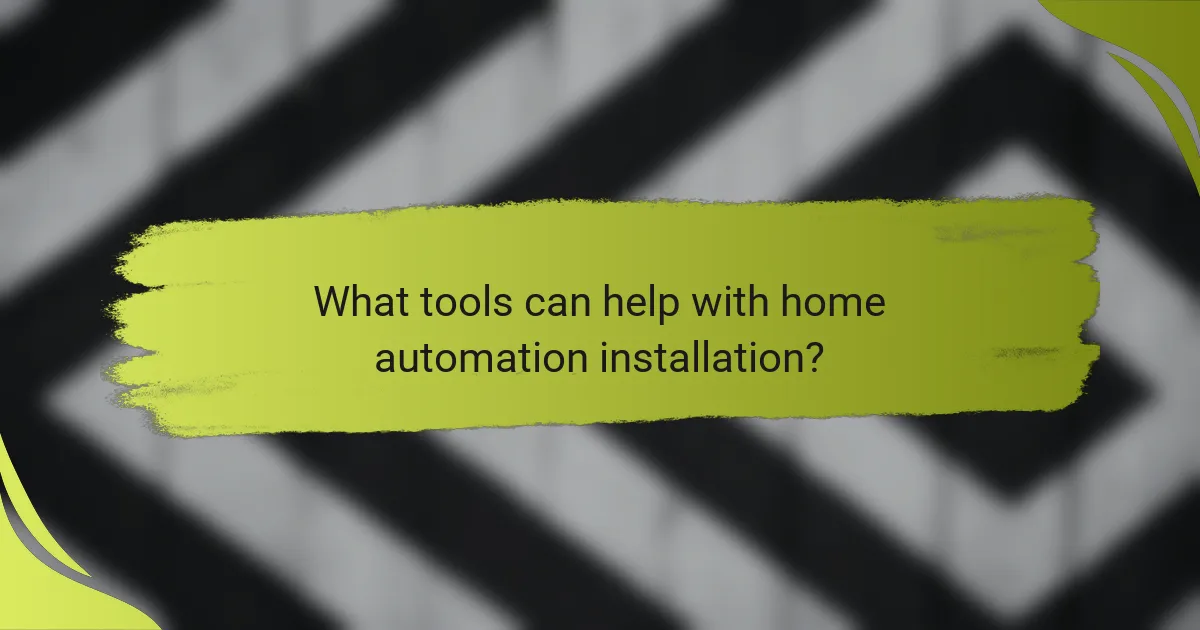
What tools can help with home automation installation?
Effective home automation installation can be greatly enhanced by using the right tools. Essential tools include smart home hubs and mobile apps, which facilitate device integration and management, ensuring a seamless setup process.
Smart home hubs like Samsung SmartThings
Smart home hubs, such as Samsung SmartThings, serve as central controllers for various devices in your home. They allow different products from multiple manufacturers to communicate with each other, simplifying the automation process.
When choosing a hub, consider compatibility with your existing devices and the range of supported protocols like Zigbee or Z-Wave. This ensures that you can connect a wide array of devices, from lights to security cameras, under one platform.
Mobile apps for device management
Mobile apps are crucial for managing and controlling your home automation devices remotely. Many smart devices come with their own apps, but using a unified app can streamline your experience.
Look for apps that offer user-friendly interfaces and robust features such as scheduling, automation routines, and real-time notifications. Avoid apps that lack regular updates or customer support, as these can lead to security vulnerabilities or compatibility issues over time.
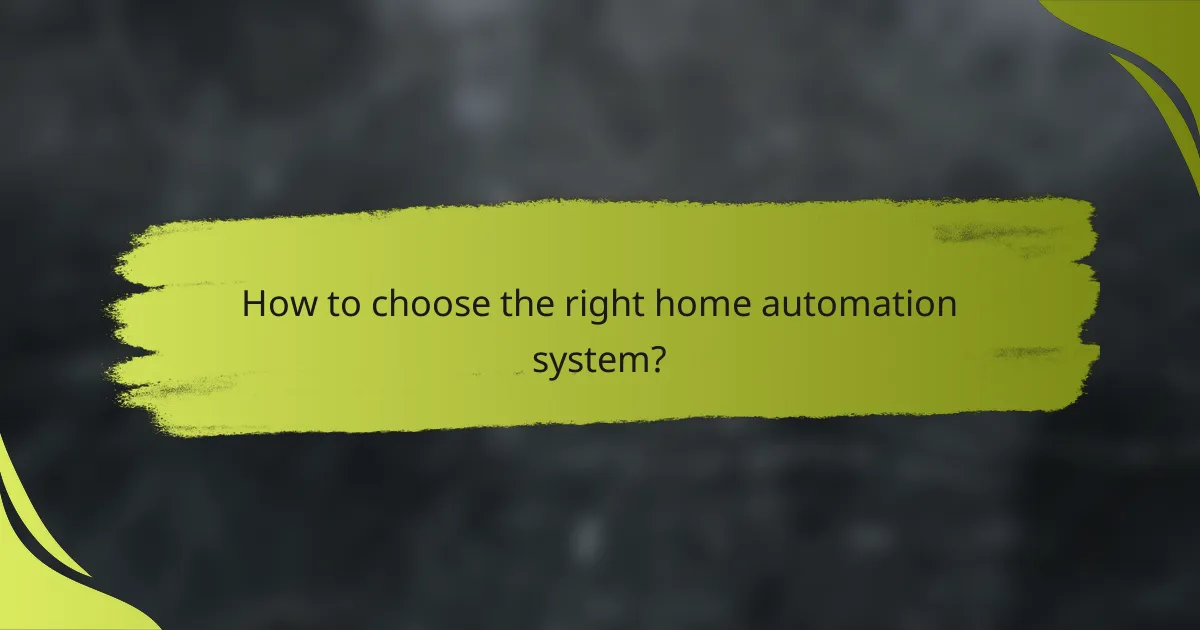
How to choose the right home automation system?
Choosing the right home automation system involves understanding your specific needs and comparing the features of leading brands. This ensures you select a system that integrates well with your lifestyle and existing devices.
Assess your specific needs
Start by identifying the areas of your home that you want to automate, such as lighting, security, or climate control. Consider how much control you want over these systems—do you prefer remote access via smartphone or automated schedules?
Next, think about compatibility with existing devices. Ensure that the home automation system you choose can integrate with your current technology, such as smart speakers or security cameras, to avoid future compatibility issues.
Compare features of top brands
Research the features offered by popular home automation brands like Google Nest, Amazon Alexa, and Apple HomeKit. Look for key functionalities such as voice control, user-friendly interfaces, and the ability to create custom routines.
Pay attention to the ecosystem each brand supports. Some systems work better with specific devices or platforms, which can influence your overall experience. For instance, if you have many Philips Hue lights, a system that easily integrates with them will enhance usability.

What are the costs associated with home automation in India?
The costs of home automation in India can vary widely based on the complexity of the system and the components chosen. Basic systems may start from around ₹20,000, while more advanced setups can exceed ₹1,00,000, depending on features and installation requirements.
Initial Setup Costs
Initial setup costs for home automation typically include the price of devices, installation fees, and any necessary wiring or infrastructure upgrades. Basic smart devices like lights and plugs can range from ₹1,000 to ₹5,000 each, while more sophisticated systems, such as smart security cameras or thermostats, can cost ₹10,000 or more.
Installation fees can vary based on the complexity of the system and the service provider. Professional installation may add an additional ₹5,000 to ₹20,000 to your overall costs, depending on the number of devices and the intricacy of the setup.
Ongoing Maintenance and Subscription Fees
Ongoing maintenance costs for home automation systems can include software updates, device replacements, and potential subscription fees for cloud services or advanced features. Some smart devices require a monthly subscription for full functionality, which can range from ₹500 to ₹2,000 per month.
It’s important to factor in these ongoing costs when budgeting for a home automation system, as they can significantly impact the total cost of ownership over time.
Potential Savings and Return on Investment
Investing in home automation can lead to savings on energy bills and increased property value. Smart thermostats and lighting systems can reduce energy consumption by optimizing usage, potentially saving homeowners ₹1,000 to ₹5,000 annually on electricity bills.
Additionally, a well-implemented home automation system can enhance security and convenience, making it a worthwhile investment despite the initial costs. Homeowners should consider these long-term benefits when evaluating the overall costs associated with home automation.
